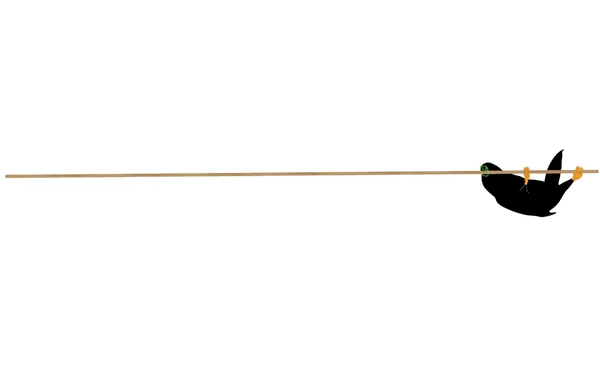[ad_1]
:focal(800x602:801x603)/https://tf-cmsv2-smithsonianmag-media.s3.amazonaws.com/filer_public/de/1e/de1e5df1-f674-465d-950b-763de3f3cd38/rosy-faced-lovebird-2-photo-by-todd-l-green_web.jpg)
A rosy-faced lovebird
Todd L. Green
Much like monkeys swinging from branch to branch, some parrots can swing through the trees with the greatest of ease, scientists have learned. But these colorful birds grip the branches with an unusual appendage: their beaks.
Rosy-faced lovebirds can use their adaptable beaks as a third limb that supports them even as they swing like gibbons and spider monkeys. In research published Tuesday in Royal Society Open Science, scientists describe how the parrots hung underneath a 3D-printed “branch” and moved along by using their beaks and hind legs in tandem to alternately grasp, swing like a pendulum, let go and reattach themselves a few inches farther along.
This method of locomotion resembles the arm-swinging style that tree-loving primates use to cruise around the forest canopy, which is known as brachiation. Because the newly observed form of parrot motion employs the birds’ mouths, the scientists have dubbed it “beakiation.”
Birds are famous as flyers, but they have plenty of other ways of getting around. Ostriches can run at over 40 miles per hour. Penguins can dive and swim faster than human Olympians. Woodpeckers are expertly adapted to climbing straight up vertical tree trunks using their toes. Edwin Dickinson, an anatomist at the New York Institute of Technology and a co-author of the study, says the researchers are particularly interested in the surprising solutions animals come up with to move around in different environments. The study points out that anatomy and behaviors don’t always match up in obvious ways; animals can co-opt body parts to do things beyond the purposes for which they evolved. “In the case of the parrots, you’re basically using your feeding system to move, and that’s a pretty complicated task from a neurological perspective,” says Dickinson.
To discover this amazing ability, Dickinson and colleagues designed an experiment for four rosy-faced lovebirds. They wanted to simulate how the parrots moved on thin branches in trees—and see how they stacked up against specialized tree-swinging primates like gibbons and spider monkeys. They designed and 3D-printed a runway 26.5 inches long and just 0.1 inch in diameter. The thin “branch” was suspended from a force plate that could measure how much load the parrots placed on it with their feet or mouth.
Because the branch was too thin to walk on, the birds had to grasp it with their feet and beak, leaving their body hanging below. Previous work had shown that while parrots perch on larger branches, they will adopt this strategy when on very thin footing. “The smaller the substrate, the harder it is to stay upright without toppling over, so the natural solution would be to go underneath and just hang,” says co-author Melody Young, an anatomist at the New York Institute of Technology.
To move forward, the birds grasped the simulated branch with their beak, then released the grasp of both hind legs simultaneously. They swung their center of mass forward like a pendulum, pivoted on the beak’s grip point and used both legs to grab the branch again about three inches farther along the structure.
The birds weren’t trained or incentivized in any way to produce the swinging style of movement. “We just put them up there, and all four birds chose to adopt this same behavior,” says Young.
The lovebirds in the experiment live at the New York Institute of Technology College of Osteopathic Medicine. How often their wild cousins, which live in the woodlands of southwestern Africa, might employ the technique is unclear.

An animation showing how a parrot uses its beak to swing along a branch
Melody W. Young
In the first trial, a small middle section of the “branch” was isolated and attached to the plate sensor, so the scientists could measure the individual force of each beak or hind limb during 142 individual trials.
Young explains that the swinging birds exerted as much force on their beaks as a swinging gibbon does on its arm, if not more. “So from a limb-loading perspective, 100 percent they are like brachiators,” she says.
But the birds didn’t measure up when it came to the efficiency with which they traveled across the simulated branch during an additional 129 trials. While gibbons are so adept at swinging from branch to branch that they recover about 80 percent of the energy output from one swing to the next, these birds were far less so at around 25 percent.
Michael Granatosky, an evolutionary biomechanist at the New York Institute of Technology and a study co-author, described the motion as a stop-start process. “When is the last time you went on some monkey bars?” he asks. “Humans are terrible brachiators, and these parrots are getting worse energy recovery than humans. That tells you it’s not very efficient from an energetic point of view.”
This rosy-faced lovebird uses its bill and feet to swing along a fake branch. The movement has been dubbed “beakiation.” Dickinson et al. Royal Society Open Science. 10: 231397./https://tf-cmsv2-smithsonianmag-media.s3.amazonaws.com/filer_public/c9/30/c930ef90-a3cd-44c5-9ff5-966bcf84d5e6/parrotsupplementalmovie1-ezgifcom-gif-to-webp-converter.webp)
Granatosky had led a previous study to quantify how much time parrots spend suspended beneath tree branches, as opposed to standing atop them. During more than 11,000 observations, the birds in a colony of monk parakeets living in Brooklyn, New York, spent about 3.6 percent of their time under the branches. That showed that while it wasn’t the way they spent most of their time, it was something they did with some regularity—close to an hour out of every 24.
But nothing quite like this hanging locomotion has been noted before in birds. A single instance of beak-suspended movement was previously reported when the Puerto Rican spindalis was observed moving from vine to vine by swinging from its beak alone. But the lovebirds use a much different type of coordinated movement of beak and legs, during which the beak functions almost as a third limb.
In fact, the beak seems to lead the way. Ryan Marek, an evolutionary biologist at University College London not involved with the research, was struck to see this particular behavior, a whole phase of parrot locomotion supported by the head and neck alone. “They are fully using their head and neck like a forelimb,” he says. “A lot of my work revolves around kind of an analogy of a surrogate forelimb, which is what the head and neck are doing together. To see it so perfectly being co-opted by an organism is just incredible.”
Some of the same authors previously reported the ability of lovebirds to use their beak as a kind of third limb while they climbed up vertical surfaces. The beaks provide nearly as much power as the birds’ legs. And, adjusted for weight, the beaks compare with the limb power of climbing primates—including human rock climbers.
Marek says many birds have a kind of hinge between their face and skull. “Parrots have just taken that to the absolute extreme,” he says. “That feature alone is very important in allowing parrots to do so many different things with their skull. It can do a range of different feeding types, and locomote at the same time, which is rare in the animal kingdom and very cool.”
Parrots display many mind-blowing behaviors. They have famously large vocabularies in human languages including, in some cases, a repertoire of choice swear words. They can use a set of tools to score a meal, or soak a meal in water to make it more palatable. Scientists recently taught lonely domesticated parrots to video chat with other birds—and found the birds benefited from the social interactions.
Now it seems the birds could have a unique method of moving around the treetops. While beakiation itself might be rare, the flexibility of animals to use their bodies for unexpected behaviors is likely much more common than we realize. “We demonstrate in this paper, and can show over and over again when we look at animals, they can come up with entirely novel solutions,” says Granatosky. “They solve problems in ways that that we would have never predicted from their anatomy alone.”
Maqvi News #Maqvi #Maqvinews #Maqvi_news #Maqvi#News #info@maqvi.com
[ad_2]
Source link





































/https://tf-cmsv2-smithsonianmag-media.s3.amazonaws.com/filer_public/de/1e/de1e5df1-f674-465d-950b-763de3f3cd38/rosy-faced-lovebird-2-photo-by-todd-l-green_web.jpg)











